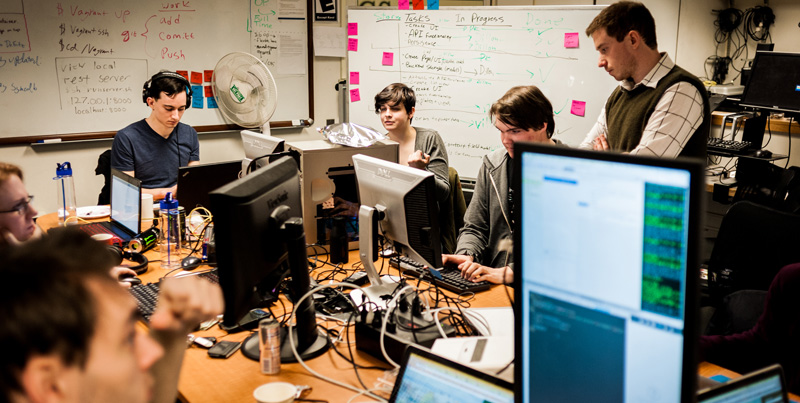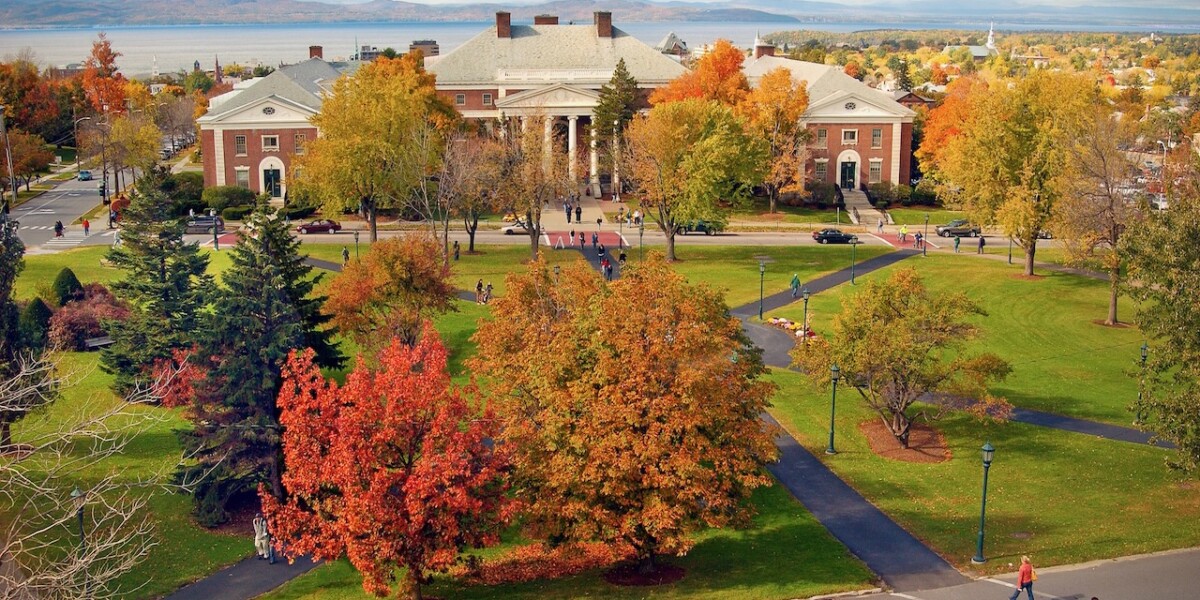By Amanda Kenyon Waite
With “Eye of the Tiger” blaring, their fists pumping and cheers erupting, a team of students jogs into the final round of the competition. No, this isn’t a basketball game, and we’re not at Patrick Gym. It’s a Saturday night at Votey Hall, and 70 students have gathered for a hackathon.
While the skills on display at the coding competition haven’t necessarily been athletic in nature, endurance has certainly played a role. For 12 hours, following four hours the night before, the eight teams have been working against each other and against the clock, developing apps with an aim to improve student life at UVM. The students are weary, but the energy is high now that it’s time to show their work to their classmates and competitors — and to their judges.
Meet the Software Engineers
A dozen software engineers from State Street, an international financial services institution headquartered in Boston, have traveled to Burlington to host the event. In partnership with UVM staff, they judged the event, and coached the students all day — looking for talent to recruit in the process. A number of UVM students in recent years have gone on to intern and fill full-time positions at the company.
What did the students create? An “impressive” range of apps, according to the judges. The “Eye of the Tiger” team’s entrance was a nod to the athletic theme of their app, designed to track availability of equipment at the fitness center. Another group created a site where students can post their reviews of UVM classes, providing helpful information during class registration time. A third group conceived of an app that could help organize carpools to the mountains during ski season.
The first-place team, who split a $1,000 award, created an app that’s of particular value to the college student: a calendar of campus events serving free food. Their site, which was built with responsive design so that it’s mobile friendly, lets users “favorite” the events they plan to attend, which triggers another mobile-friendly feature: the addition of that event to the user’s calendar. The team was also able to integrate a Google map of campus, dotted with friendly pizza and coffee icons that correspond to upcoming events.
More important than the what, though, at this hackathon was the how. The purpose of the competition was to train students in the “Agile” method, a system of project management gaining popularity in the software development world. At a training session Friday night, before the competition officially began, State Street Vice President Hung Tran gave students a crash course. Unlike more traditional models, which involve intensive documentation before a project begins and then minimal contact with the client until product delivery much later, the Agile method is structured with short phases of work punctuated with frequent assessment and potential revision. Among other benefits, this system minimizes the risk of creating a product that doesn’t meet the needs of the client or the always-changing marketplace.
A Recipe for Success
The Agile method gave the students a framework to organize their work, stay on task and connected to each other and their coaches throughout the hackathon — just the structure they needed to develop functioning apps from scratch in less than 24 hours.
“Trying to coordinate and work with everybody and make sure that what we’re doing isn’t going to break what someone else is doing is quite a challenge,” says UVM senior computer science major Paul Kiripolsky, whose team won the second place prize of $400. “But it’s a lot of fun, and it’s a good work experience, as well.”
“Doing things like this can really help to give our students great experiences beyond what we’re teaching in the classroom,” says Maggie Eppstein, chair of Computer Science, who, along with lecturer Robert Erickson and the UVM Career Center, worked with State Street to make the event possible. “Most hackathons don’t provide any direction about how the teams should collaborate. Having professional software engineers coach the Agile method makes this event really unique,” she says.
While this is the first hackathon the department has organized, it’s not the first public event or partnership with regional businesses. Annually, Computer Science hosts a CS Fair, a chance for students to share their work with campus and network with potential employers. Providing these enrichment opportunities is a priority for Eppstein to meet the needs of a rapidly growing area of study; the number of CS majors has more than doubled in the past five years at UVM.
But as much as the event was tailor made for CS students, it also attracted a number of students from across the disciplines — including business, electrical engineering, economics and even psychology majors. Junior Jackson Donovan, a business major, says he participated for the experience collaborating and working with programmers, a key skill for his potential career interest in tech marketing. And the event led to collaboration among students of different levels. The winning team, for example, was composed of two first-years, a sophomore, junior, senior and two grad students.
“That was our goal,” says Lisa Strack, vice president of university relations at State Street, “to reach a broad set of students, which is the talent we want to recruit, to share Agile with them, get them excited about State Street, about working in financial services — and to have fun.”

Amanda Kenyon Waite is the Web News Editor at UVM Communications.
This piece was originally published by UVM Today.





